Public premises and events are strongly encouraged by ProtectUK and the National Counter Terrorism Security Office (NaCTSO) to provide Public Access Trauma (PaCT) kits. Furthermore, 'Martyn’s Law' is a bill being pursued by government, which would mandate any public premises or event with a capacity of over 200 to consider the risks arising from a terrorist attack and have plans in place to mitigate physical harm in the event of one occurring.
Bleed Control Cabinets, Points & Stations

Provide immediate and effective assistance to stop life-threatening bleeding before professional medical services arrive
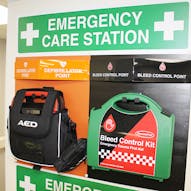
Combine two first aid points in one modular unit to keep your emergency kits in one easily identifiable location

_web.png?auto=compress&lossless=1&w=191)
- Create an easy to identify focal point to ensure your Bleed Control Kit can be easily accessed
- Provide immediate response to stop severe bleeding

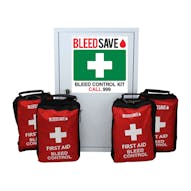
- Secure lockable cabinet to keep Bleed Control Kits safely stored
- Clearly labelled ‘Bleed Control Kit’ sign for quick identification of emergency supplies


Supplied with your choice of fully stocked Basic Bleed Control Kits


Supplied with your choice of fully stocked Enhanced Bleed Control Kits


Supplied with your choice of fully stocked Comprehensive Bleed Control Kits

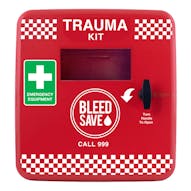
Ideal storage of specialist first aid components such as Public Access Trauma kits or Bleed Control Kits


Secure lockable cabinet to keep Bleed Control Kits safely stored

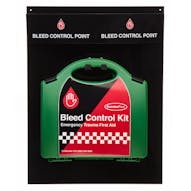
Supplied with a fully stocked Basic Bleed Control Kit this compact, highly visible unit provides immediate access to life-saving tools

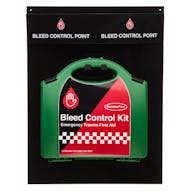
Supplied with a fully stocked Enhanced Bleed Control Kit this compact, highly visible unit provides immediate access to life-saving tools

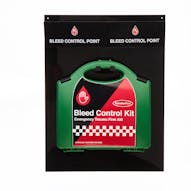
Supplied with a fully stocked Comprehensive Bleed Control Kit this compact, highly visible unit provides immediate access to life-saving tools
Guidance On Enhanced First Aid Provision & Preparedness
Why Should I Enhance My First Aid Provisions?
Basic first aid provision is a legal requirement and is common among organisations. However, enhanced first aid provision and preparedness is also strongly recommended by several official bodies in everyday settings:
Public premises and events

Workplaces or sites with any hazards

Workplaces or sites with any hazards such as machinery, sharp or moving objects which have potential to cause critical injuries such as major bleeding must have 'adequate and appropriate’ first aid for any risks present. Alongside other health and safety measures, this may be achieved by adding bleed control products to existing first aid provisions, or adding Workplace Critical Injury Packs compliant to BS8599-1.

Whether the risk being considered is a terrorist/public attack or a serious accident on site – major bleed injuries are often a fatal consequence. However, they can be treated with readily available and affordable equipment, which can be used with minimal or no training. The sooner a person with life threatening injuries receives appropriate first aid and treatment, the greater their chances of survival.
Basic first aid provisions such as an HSE or BS8599-1 compliant first aid kit do not have any items to treat major bleeding, yet thousands of UK workplaces and sites will have machinery or equipment which could cause a critical injury in the event of an accident or malfunction.
Many workplaces, organisations, public premises and events provide defibrillators which save hundreds of lives every year. Trauma and Bleed Control provisions are significantly more affordable, easier to implement and could save multiple lives in the event of a mass casualty situation.
There have been 14 terror attacks in the UK since the start of 2017. Furthermore, the UK's Intelligence Services and Counter Terrorism Policing have disrupted 39 late-stage terror attacks and are investigating 800 live cases annually.
Subsequently, the threat level facing the UK is currently set at 'substantial', meaning an attack is likely.
What Should I Consider When Enhancing First Aid Provisions?
The Health and Safety Executive state “First aid provision must be 'adequate and appropriate in the circumstances'. This means that you must provide sufficient first aid equipment (first aid kit), facilities and personnel at all times”.
First aid supplies should be placed in locations that are accessible to the public and usable by individuals, irrespective of their training background.
As part of their counter terrorism awareness guidance, ProtectUK and the National Counter Terrorism Security Office (NaCTSO) recommend that first aid provisions ‘should support the administrating of immediate, lifesaving first aid’.
The provisions should be ‘well advertised across the premises’ and be clearly signposted, ensuring all staff, visitors and guests are made aware of them for ease of identification in an emergency. Consider the use of signage to assist with ensuring provisions can be quickly found, with regular reminders and information on the nearest provisions as necessary.

Is your first aid kit adequate?
ProtectUK recommend that "organisations should undertake an assessment to determine if the current first aid kit, such as workplace first aid kits, are adequate for the treatment of immediate life-threatening injuries". Additionally, the Health and Safety Executive state that risk assessments must "consider the circumstances of your workplace, workforce and the hazards and risks that may be present."
It is recommended that consideration should be given to:
- do they support the treatment of those with major bleeding?
- do they support those who are not breathing as a result of unconsciousness or an obstructed airway, typically after a head injury or cardiac arrest?
- are they able to help more than one injured person?
Additional supplies to supplement basic first aid provision may include:
- Public Access Trauma Kits (PAcT)
- Products or Kits to treat major bleeding, such as Tourniquets, Trauma/Pressure Dressings, Wound Packing, Haemostatic Dressings and Granules
- Casualty Stretchers and Evacuation Products
- Resuscitation Products such as guedal airways
- Defibrillators
- Additional items to treat and manage shock
Why Should Organisations Ensure Adequate First Aid Preparedness For Mass Casualty Events?
Protect UK strongly encourage public and private sector organisations to 'enhance first aid preparedness and response planning, so it takes into account the likely injuries which can be the result of a malicious event, such as a terrorist attack'.
It is common for organisations to have a basic level of first aid preparedness not only to comply with legal requirements, but also as a means to enhance the first aid resilience of their workforce. This effort is aimed at safeguarding the welfare of employees, visitors, and anyone in the vicinity of a business premises by offering humanitarian assistance to those in need.
By enhancing their level of first aid provisions, an organisation contributes to strengthening their own and the general population's ability to perform life-saving first aid effectively, which will undoubtedly increase the survival chances of individuals with life-threatening injuries.
Furthermore, the Terrorism (Protection of Premises) Bill, also known as Martyn’s Law, will require those responsible for publicly accessible premises with capacities over 200 to take steps to reduce the threat to the public from terrorist attacks, through assessing risks and having appropriate measures in place to mitigate physical harm.
Under current proposals, an inspection regime will be put in place with full powers of entry into any qualifying location. Regulators will have a range of sanctions to address non-compliance with the proposed law, and will be able to impose penalties, including restriction notices or fines of up to £18m or 5% of worldwide revenue.
Having first aid provisions to treat critical injuries readily to hand and clearly signposted is a reasonably practicable and effective step for organisations to take as part of these plans.

What Is The Care Gap?
The care gap is the time between an incident that causes a medical emergency and the arrival of professionals who can treat the casualty immediately. When a medical emergency occurs, people expect an ambulance to be immediately deployed, arrive in a matter of minutes, and for the casualty to receive medical attention immediately upon arrival.
But when a mass casualty event occurs, alongside logistical challenges and any dangers still present, there can simply be too many casualties and too few paramedics, so some casualties have to wait to be treated. This is when the care gap becomes too large, and further damage or even death can result from a lack of prompt medical intervention.

Traumatic injuries such as major bleeds can result in death in minutes, but having provisions to stop severe bleeding readily available and easy to access can be vital in keeping casualties alive until professional help arrives.
This is also the case for premises with machinery or sharp/moving objects where there is a risk of a major bleed injury occuring. The time it takes to bleed out from a critical bleed is often less than the fastest time it takes for an ambulance to arrive. This is an example of the care gap and why any premises where there is a risk of a critical bleed injury occuring should be prepared with enhanced first aid provisions, such as a Critical Injury Pack compliant to BS8599-1 or having bleed control products included alongside basic first aid provisions.
Why Should I Add Bleed Control Products To Workplace First Aid Provisions?
The Health and Safety Executive state "First aid provision must be 'adequate and appropriate in the circumstances'. This means that you must provide sufficient first aid equipment (first aid kit), facilities and personnel at all times".
ProtectUK recommend that 'organisations should undertake an assessment to determine if the current first aid kit, such as workplace first aid kits, are adequate for the treatment of immediate life-threatening injuries'. Additionally, the Health and Safety Executive state that risk assessments must "consider the circumstances of your workplace, workforce and the hazards and risks that may be present."

It is recommended that consideration should be given to:
- do they support the treatment of those with major bleeding?
- do they support those who are not breathing as a result of unconsciousness or an obstructed airway, typically after a head injury or cardiac arrest?
- are they able to help more than one injured person?
Workplaces, premises, facilities or sites with any hazards such as machinery, equipment, sharp or moving objects which have potential to cause critical injuries such as major bleeding must have 'adequate and appropriate’ first aid for any risks present. Alongside other health and safety measures such as correct training, procedures and installing safety signage, this may be achieved by adding bleed control products to existing first aid provisions, or adding Workplace Critical Injury Packs compliant to BS8599-1 which are designed to be issued as a supplementary resource to small, medium or large first aid kits.
Basic first aid provisions such as an HSE or BS8599-1 compliant ‘standard’ first aid kits do not have any items to treat major bleeding, yet thousands of UK workplaces and sites will have machinery or equipment which could cause a critical injury in the event of an accident or malfunction.
The time it takes to bleed out from a critical bleed is often less than the fastest time it takes for an ambulance to arrive, so having provisions to stop severe bleeding readily available and easy to access can be vital in keeping casualties alive.
This is an example of the care gap and why any premises where there is a risk of a critical bleed injury occuring should be prepared with enhanced first aid provisions, such as a Critical Injury Pack compliant to BS8599-1, or having bleed control products included alongside basic first aid provisions.
The simple and small investment of adding bleed products such as tourniquets, trauma dressings and haemostatics to your organisations first aid provisions could save lives.
By enhancing their level of first aid provisions, an organisation contributes to strengthening their own and the general population's ability to perform life-saving first aid effectively, which will undoubtedly increase the survival chances of individuals with life-threatening injuries.
Why Buy From EurekaDirect?
Unrivalled Range – Choose from over 15,000 products!
Expert Product Advice and guidance on regulations
Get 1 Free Offers - ensures best-selling products are available at great prices!
Free Next Day Delivery on all orders*
Instant Credit for all established UK businesses – pay on invoice!
Talk to our friendly customer service team! Via freephone or live chat
Hundreds of 5 star Trustpilot reviews - placing an order is fast and simple



